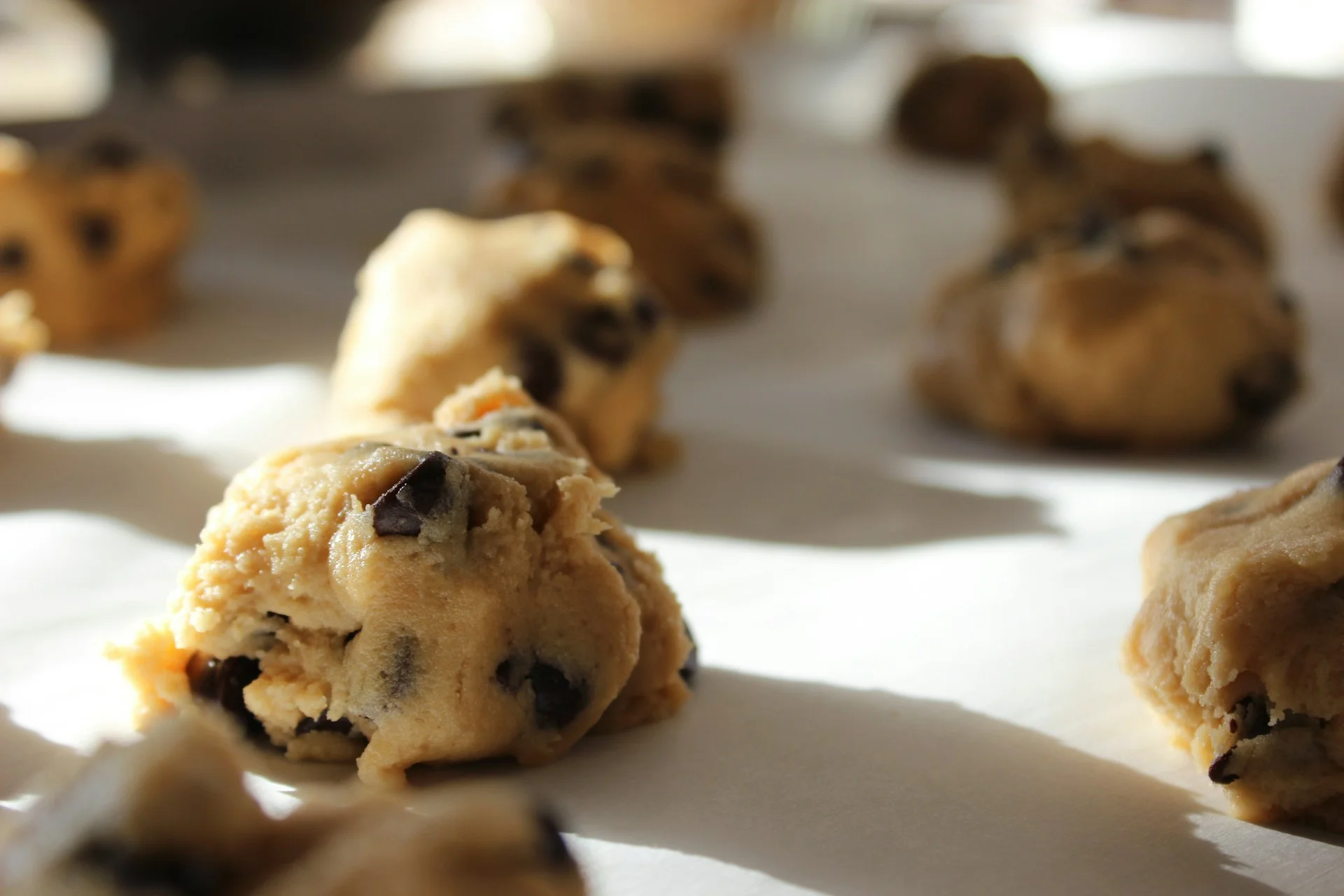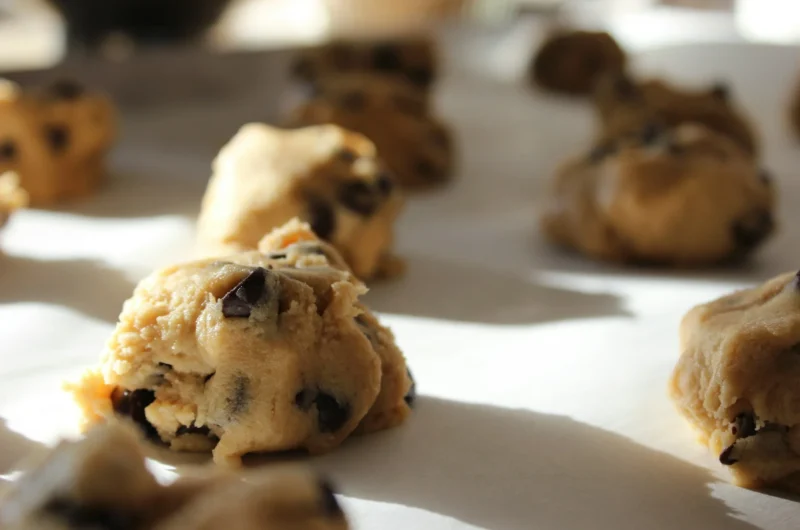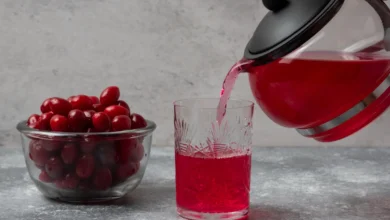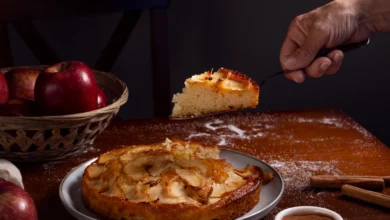Cookie Dough Cravings: Safe and Delicious Treat
I can’t be the only one who, as a kid, snuck spoonfuls of cookie dough while Mom wasn’t looking. Who could resist that raw, sweet taste? Of course, the dangers of eating uncooked eggs always lurked at the back of my mind. These days, I still get those cravings, but no way am I risking food poisoning! With a dedicated chocolate chip cookie dough recipe, it’s time for a grown-up solution to our dough-loving ways.
Forget waiting for leftovers after a baking session (not that we usually have any with those crispy chocolate chip cookies around!). An egg-free cookie dough recipe lets you create the chocolatey treat intentionally. There’s absolutely no need to wait…you can whip some up from scratch, toss it in the freezer for a few minutes to get that irresistible chill, and boom! Enjoy your homemade snack in an instant. Of course, for those short on time, ready-made edible cookie dough variations similar to cookie dough by Pillsbury can often be found in grocery stores.
Contents
- Cookie Dough
- Cookie Dough Recipe
- Ingredients
- Directions
- Notes
- How to Store Edible Cookie Dough
- All recipes Community Tips and Praise
- Frequently Asked Questions
- How do I Moisten Dry Cookie Dough
- How do I make a smaller batch?
- Is it okay to turn any cookie recipe into edible cookie dough?
- Can you bake Edible Cookie Dough?
- How do you store leftovers?
- Is cookie dough safe to eat?
- Best cookie dough flavors
- How long does cookie dough last in the fridge?
- Can I freeze this cookie dough?
- Can I bake this cookie dough?
- Would this edible dough work well as an ice cream mix-in?
- What is cookie dough made of?
- Can you eat raw cookie dough?
- Why is cookie dough so popular?
- Does cookie dough have milk?
Cookie Dough
Here’s a bonus – a delicious batch of edible cookie dough makes a fun surprise for friends. And trust me, I won’t tell anyone if you keep a small batch in the fridge ready to go – those late-night cookie dough cravings won’t know what hit them! Plus, these doughy bites can last for up to 3 months in the freezer for whenever that sweet tooth strikes.
Is Raw Flour Safe to Eat?
Remember those times we indulged as kids – a furtive bite of raw cookie dough, maybe even a lick of raw cake batter? Let’s be honest, the dough always tasted amazing, even better than the final cake or cookie. The thrill was partly because we knew we maybe shouldn’t! Maybe you never noticed any ill effects, but that doesn’t mean you should tempt fate.
The chances of getting sick from eating raw dough or batter might be low, but do you honestly want to take the chance? The reality is, it’s surprisingly risky. It’s not just about raw eggs, which definitely carry a danger of Salmonella. Uncooked flour can host harmful bacteria like E. coli. While baking kills these, eating the dough raw means there’s a risk they could wreak havoc on your system.
You might be wondering – is there a way to make raw cookie dough safe to eat? The good news is yes! By choosing recipes that don’t include raw eggs and use heat-treated flour, you can still enjoy that delicious doughy goodness. Remember, both flour and eggs can carry bacteria like salmonella and E. coli, which are the real dangers.
While salmonella and E. coli won’t necessarily turn deadly, they can make you very sick. It’s not worth the risk, especially when it’s so easy to find safe, edible version recipes online. Ditch the danger and stick to the doughs specifically designed for snacking!
What Makes This Cookie Dough Edible?
So, what’s the difference between traditional cookie dough – the kind we know is unsafe to consume before it’s baked – and its snackable cousin? It comes down to two key things:
- Eggs: The absence of raw eggs is crucial. Edible cookie dough recipes cleverly replace the binding and structural role of eggs with other ingredients.
- Heat-Treated Flour: While we usually think of all-purpose flour as an innocuous baking staple, it can carry potential danger when eaten raw. Edible cookie dough uses flour that has been heat-treated to a high temperature. This effectively kills off any dangerous bacteria lurking within. The process is simple and something easily done at home before incorporating the flour into the dough.
How to Make Edible Cookie Dough
Detailed ingredient list, step-by-step instructions, and recipe basics
Edible Cookie Dough Ingredients
- Heat-Treated Flour: Traditional all-purpose flour isn’t considered safe when raw. The process of heat-treating ensures any harmful bacteria is eliminated.
Heat-Treating Instructions: Spread flour in a thin layer on a microwave-safe plate. Microwave in 30-second intervals, stirring between, until a food thermometer reads 165 °F (ca. 74 °C).
Note: You can also heat-treat flour by spreading it on a baking sheet and toasting in an oven at 350 degrees F for 5–6 minutes.
- Brown Sugar: Provides a classic sweet, slightly warm flavor to the dough.
- Butter (Softened): Creates richness and binds the dough. Beat the butter until light and fluffy for the best texture.
- Vanilla Extract: Enhances the overall flavor profile.
- Salt: Just a pinch helps balance the sweetness and brings out other flavors.
- Milk: Adds essential moisture and gives the dough a smoother texture. Gradually add more liquid until the dough reaches your desired softness.
- Chocolate Chips: There’s room for experimentation! Go for classic semisweet, a fun blend, or even mini chocolate chips for a different experience.
RELATED: Soft Apple and Salted Caramel Cookies
RELATED: How to Moisten Dry Cookie Dough
How Do You Make Edible Cookie Dough?
Here’s a brief overview of what to expect when you make an edible cookie dough recipe:
- Heat-treat the flour: Follow the instructions above or those within your chosen recipe. This step usually involves using your microwave and takes just a few minutes.
- Combine Ingredients: Cream together butter and sugars, add flavorings, then gradually mix in the heat-treated flour. Incorporate milk for desired consistency, as the dough should be slightly crumbly.
- Fold in Chocolate Chips: Stir in your chocolate chips (or other yummy mix-ins)
- Chill & Enjoy: A quick chill in the fridge firms up the dough and enhances the flavor
Nutrition Facts
Nutrition Facts (per serving)
- Calories: 348
- Fat: 19g
- Carbs: 46g
Cookie Dough Recipe
Course: Cakes and DessertsCuisine: American16
10
minutes15
minutes348
kcal25
minutesHere is the recipe ingredients, and instructions. You can also print the recipe for your ease.
Ingredients
1 cup all-purpose flour (heat-treated)
¾ cup packed brown sugar
½ cup butter (softened)
1 teaspoon vanilla extract
½ teaspoon salt
2 tablespoons milk
½ cup milk chocolate chips
½ cup mini chocolate chips
Directions
- Heat-Treat Flour: Spread flour on a microwave-safe plate. Microwave on high in 30-second intervals, stirring between each, until it reaches 165°F.
- Cream & Combine: Beat sugar and butter until light and fluffy. Add vanilla and salt, then mix in heat-treated flour until crumbly. Add milk bit by bit until just combined.
- Fold & Enjoy: Fold in chocolate chips. Chill for a firmer texture, or enjoy immediately!
Notes
- For a smaller batch, check the article’s “Frequently Asked Questions” section for a ‘Cookie Dough for Two’ recipe.
- Experiment with different flavors – add caramel bits, chopped nuts, or your favorite mix-ins!
How to Store Edible Cookie Dough
To make the most of your edible cookie dough, proper storage is key. Keep it in an airtight container in the refrigerator for up to one week for immediate snacking. For longer storage, freeze it in an airtight container for up to one month. Before enjoying frozen dough, let it thaw briefly for the best texture.
All recipes Community Tips and Praise
It seems like everyone’s loving this edible cookie dough craze! “This recipe is AMAZING,” says one community member. “Be warned, though – it makes a large amount of cookie dough. Luckily, I split it with a friend so we wouldn’t eat it all ourselves!”
Others chime in with creative variations. “I followed the recipe exactly,” notes a baker, “but I also added a handful of sprinkles. Super delicious, will definitely make this again!”
Several reviewers are finding that this edible dough beats anything bought in a store. “This tastes just like the best shop in town that charges $5 for a little scoop,” one enthusiast raves. “So happy I found this recipe!” Another comments, “Absolutely delicious! I mixed a few scoops with vanilla ice cream for the ultimate chocolate chip cookie dough ice cream – the whole family loved it!”
Final Words
Remember those forbidden childhood nibbles of raw cookie dough? Now, there’s no need to worry about safety concerns! Edible cookie dough lets us indulge in that sweet, nostalgic flavor whenever the craving strikes. Whether you whip up a batch using heat-treated flour and an egg-free recipe, or grab a convenient store-bought version, you can enjoy this irresistible treat guilt-free. So, go ahead – treat yourself to a spoonful (or two!) of pure cookie dough bliss!
______________________________________
Frequently Asked Questions
How do I Moisten Dry Cookie Dough
Accidentally overmixed your dough or forgot to add enough moisture? Don’t worry! You can moisten your dry cookie dough. Fix dry, crumbly cookie dough by adding small amounts of liquid at a time. This could be water, milk, an extra egg yolk, or a touch of melted butter. Knead the extra ingredient in gradually until the dough reaches a workable texture. Remember, a little goes a long way!
How do I make a smaller batch?
Absolutely! Many people don’t need a huge amount of cookie dough. Here’s a simplified recipe perfect for two:
Cookie Dough for Two:
- 1/4 cup all-purpose flour (heat-treated)
- 2 Tbsp unsalted butter (room temperature, very soft)
- 2 Tbsp light brown sugar (packed)
- 1 Tbsp granulated sugar
- 1/4 tsp vanilla
- 1/8 tsp sea salt
- 1/4 cups mini chocolate chips (or other additions)
- 1 tsp milk (as needed)
As long as you replace eggs with milk (or use pasteurized eggs) and heat-treat flour, you should be able to turn most cookie dough recipes into edible versions. Here are some that often work well:
- Oatmeal Chocolate Chip
- Dark Chocolate Butterscotch
- Peanut Butter Chocolate Chip
- Chocolate Dipped Gingerbread
- Brown Butter Chocolate Chip
Can you bake Edible Cookie Dough?
While technically possible, edible cookie dough isn’t ideal for baking. Since it lacks leavening agents (baking soda, eggs), cookies might not turn out the way you expect. If you’re curious, test a small portion at 350 °F (ca. 177 °C) with chilled, ball-shaped dough.
How do you store leftovers?
Store edible cookie dough in the fridge for a few days or the freezer for longer. For easy future snacking, portion dough using a small cookie scoop (around 2 tsp each). Place dough balls on a sheet pan and chill till firm, then transfer to a large freezer bag.
Edible cookie dough recipes eliminate the salmonella risk from raw eggs, and heat-treating flour kills potential pathogens. Always follow instructions carefully!
The possibilities are endless! For flavor variations, try:
- Salted caramel pieces
- Chopped dark chocolate
- Hazelnut spread
- Crumbled cookies and mini marshmallows
- Apple and cinnamon
Cookie dough stays good in the fridge for about four days.
Yes! Roll dough into balls, freeze on a parchment-lined tray until solid, then store in a freezer bag for up to three months.
While this dough is designed to be eaten raw, I don’t recommend baking it directly. Since it lacks traditional eggs and leavening agents, cookies may spread excessively and have an unusual texture. If you want classic baked cookies, it’s better to start with a recipe specifically meant for that purpose. However, crumbled edible cookie dough makes a delicious topping for ice cream or poached fruit!
Would this edible dough work well as an ice cream mix-in?
Absolutely! Freezing chunks of dough before adding helps prevent melting and keeps its shape in the ice cream.
Typical ingredients include flour, butter, sugar, salt, vanilla, and chocolate chips. Edible cookie dough avoids raw eggs and uses heat-treated flour.
Traditional cookie dough with raw eggs carries a risk of salmonella. Stick to edible recipes designed for raw consumption.
Its nostalgic taste, buttery texture, and the simple joy of sneaking a spoonful likely contribute to its wide appeal.
Yes, most recipes include milk. It enhances flavor and creates a creamier texture.






